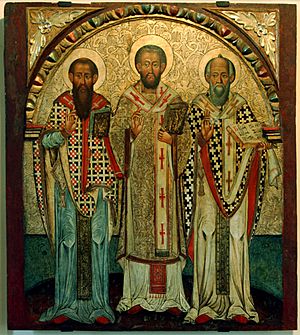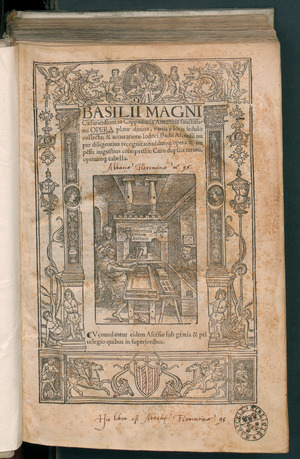Basil of Caesarea facts for kids
Quick facts for kids SaintBasil the Great Μέγας Βασίλειος |
|
|---|---|

Icon of St. Basil the Great from the St. Sophia Cathedral of Kiev
|
|
| Bishop, Confessor and Doctor of the Church; Great Hierarch | |
| Born | 330 Pontus Polemoniacus (modern-day Niksar, Turkey) |
| Died | 1 or 2 January 378/9 (aged 48) Caesarea Mazaca, Cappadocia (modern-day Kayseri, Turkey) |
| Venerated in | |
| Canonized | Pre-congregation |
| Feast |
|
| Attributes | Vested as bishop, wearing omophorion, holding a Gospel Book or scroll. St. Basil is depicted in icons as thin and ascetic with a long, tapering black beard. |
| Patronage |
|
Basil of Caesarea, also known as Saint Basil the Great (born around 330 – died 379), was an important Christian leader. He served as a bishop in Caesarea Mazaca in Cappadocia, which is now part of Turkey. Basil was a very influential thinker and writer about Christian beliefs.
He strongly supported the Nicene Creed, which explains that Jesus is fully God. He also spoke out against ideas that he believed were wrong, like Arianism, which taught that Jesus was not fully divine. Basil was good at both understanding deep religious ideas and working with powerful people. This made him a strong defender of the Nicene Creed.
Besides his work as a theologian, Basil was famous for helping people in need. He created rules for monks to live together in communities. These rules focused on praying together, living simply, and doing manual labor. Because of his work, he is seen as a founder of communal monasticism in Eastern Christianity. Both Eastern and Western Christianity consider him a saint.
Basil, his brother Gregory of Nyssa, and his friend Gregory of Nazianzus are known as the Cappadocian Fathers. The Eastern Orthodox Church and Eastern Catholic Churches call him, along with Gregory of Nazianzus and John Chrysostom, one of the Three Holy Hierarchs. The Roman Catholic Church recognizes him as a Doctor of the Church, a title given to saints whose writings are very important.
Contents
Who Was Basil the Great?
His Early Life and Education
Basil was born into a wealthy Christian family in Cappadocia around the year 330. He was one of ten children. His parents were known for their strong faith. His grandmother, Macrina, helped raise him and four of his siblings. All five of them are now honored as saints.
Basil received a good education. He studied in Caesarea Mazaca (modern Kayseri) around 350-351. There, he met Gregory of Nazianzus, who became his close friend. Basil continued his studies in Constantinople and Athens. In Athens, he also met Julian the Apostate, who later became emperor. Basil finished his studies in 356 and returned to Caesarea. For a short time, he worked as a lawyer and teacher.
Basil's life changed when he met Eustathius of Sebaste, a bishop who lived a very simple, religious life. Basil decided to leave his career and dedicate his life to God.
Becoming a Monk
After being baptized, Basil traveled in 357 to learn about different ways of living a religious life. He visited places like Palestine, Egypt, and Syria. He gave away his wealth to the poor. For a short time, he lived alone near his family's estate in Pontus. However, Basil soon realized that living alone was not for him. He felt called to live in a community with other religious people.
By 358, Basil started gathering a group of followers, including his brother Peter. They founded a monastic community on his family's land near Annesi. His widowed mother, Emmelia, and sister, Macrina, also joined. They lived lives of prayer and charity. Basil wrote about this communal way of life. His writings became very important for the development of monastic traditions in the Eastern Church.
Basil's Role in the Church

In 362, Basil became a deacon, and in 365, he became a presbyter (priest) in Caesarea. He and his friend Gregory Nazianzus worked together to fight against Arianism. This belief system caused a lot of disagreement among Christians. Basil and Gregory were very successful in public debates against Arian thinkers. This showed them that their future was in leading the Church.
In 370, Basil was chosen to be the bishop of Caesarea. This made him a very powerful leader in the region. He was known for being both strong-willed and very kind. During a famine, he personally organized a soup kitchen and gave food to the poor.
Basil also built a large complex outside Caesarea called the Basiliad. This complex included a poorhouse, a hospice (a place for the sick), and a hospital. People at the time compared it to the wonders of the world.
Basil was a strong defender of Christian beliefs. He even stood up to the Emperor Valens, who supported Arianism. Valens tried to banish Basil several times, but he never succeeded. Valens was so impressed by Basil that he eventually donated land for the Basiliad. This event helped show that the government's power had limits when it came to the Church.
What Did Basil Write?

Basil wrote many important theological works. One of his main writings is On the Holy Spirit. In this book, he used the Bible and early Christian teachings to show that the Holy Spirit is divine, just like God the Father and Jesus. He also wrote Refutation of the Apology of the Impious Eunomius, which argued against the ideas of Eunomius, a leading Arian thinker.
Basil was also a famous preacher. Many of his sermons have been saved. These include talks given during Great Lent about the Hexameron, which describes the six days of creation. Some of his sermons are important for understanding the history of morals, like his talks against charging high interest on loans or about the famine in 368. He also wrote an address to young men about studying classical literature. In one sermon, he even described an early method of desalination, where sailors would get fresh water from boiling seawater.
Basil believed in understanding the deeper, spiritual meaning of the Bible. He wrote that just reading the literal sense is like having a "veil" over your heart. He also wrote ethical guides for people living in the world and for those in monasteries.
Basil believed that men and women are completely equal. He wrote that both are made in the image of God and have the same honor and dignity. He also discussed slavery, saying that no human is "a slave by nature." He believed slavery was a result of humanity's fall from grace.
Basil's many letters show his personality. They reveal him to be observant, optimistic, kind, and even playful, despite his health problems and church conflicts. He is seen as the main person who shaped monastic life in the Greek Church.
Basil's Impact on Church Services
Basil of Caesarea played a very important role in the history of Christian church services, known as liturgy. It is clear that Saint Basil helped create or improve existing church services. This is supported by the long-standing traditions of the Byzantine Church and many old writings.
Most of the church services named after Basil are not entirely his work today. However, they still show his influence in creating prayers and promoting church songs. Experts agree that the Liturgy of Saint Basil "clearly shows the personal touch, mind, and heart of St. Basil the Great."
One important service linked to him is The Divine Liturgy of Saint Basil the Great. This service is a bit longer than the more commonly used Divine Liturgy of St. John Chrysostom. The main differences are in the quiet prayers said by the priest and in the use of a specific hymn to the Theotokos (Mother of God).
The Eastern Churches also use many other prayers that are said to be from Basil. These include prayers for exorcism, morning and evening prayers, and prayers for different times of the day.
How Basil Influenced Monasticism
- Further information: Eastern Christian monasticism#Byzantine monasticism
Basil helped make monastic life more balanced. He encouraged monks to have a good mix of work and prayer. He is remembered as one of the most important people in the development of Christian monasticism.
Basil is not only seen as the father of Eastern monasticism, but his ideas also influenced the Western Church. This is largely because of his impact on Saint Benedict, who wrote the famous Rule for Western monks. Benedict himself recognized Basil's importance. He wrote that his monks should read "the Rule of our Holy Father, Basil." Basil's teachings on monasticism were brought to the West by Rufinus in the late 4th century.
Because of Basil's influence, many religious groups in Eastern Christianity are named after him. In the Roman Catholic Church, the Basilian Fathers, a group of priests and students, are also named after him.
Remembering Saint Basil
Basil was given the title Doctor of the Church in the Western Church. This was because of his important contributions to discussions about the Trinity (God as Father, Son, and Holy Spirit). He helped define terms like "ousia" (essence or substance) and "hypostasis" (person or reality). His biggest contribution was insisting that the Holy Spirit is divine and of the same nature as the Father and the Son.
In Greek tradition, Basil is believed to bring gifts to children every 1 January, which is St. Basil's Day. On this day, it is traditional to serve vasilopita, a special bread baked with a coin inside. This tradition comes from Saint Basil himself. When he was a bishop, he wanted to give money to the poor. He asked women to bake sweet bread and secretly placed gold coins inside. Families who cut the bread were happily surprised to find the coins.
On his feast day, people often visit friends and relatives, sing New Year's carols, and set an extra place at the table for Saint Basil. Basil, who came from a wealthy family, gave away all his belongings to help the poor, those in need, and children.
The Eastern Orthodox Church celebrates his feast day on 1 January. The Roman Catholic Church celebrates him along with Saint Gregory Nazianzen on 2 January. Other Christian churches also celebrate him on different dates throughout the year.
Many relics (holy objects) of Basil exist around the world. One of the most important is his head, which is kept at the monastery of the Great Lavra on Mount Athos in Greece.
Images for kids
-
Statue of Saint Basil, depicting him in Western vestments, in the Church of St. Nicholas, Malá Strana, Prague, Czech Republic.
See also
 In Spanish: Basilio el Grande para niños
In Spanish: Basilio el Grande para niños
- Basilian monk
- Pseudo-Basil



